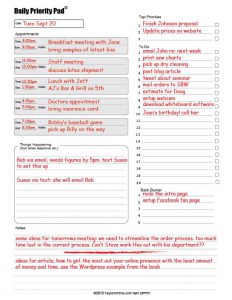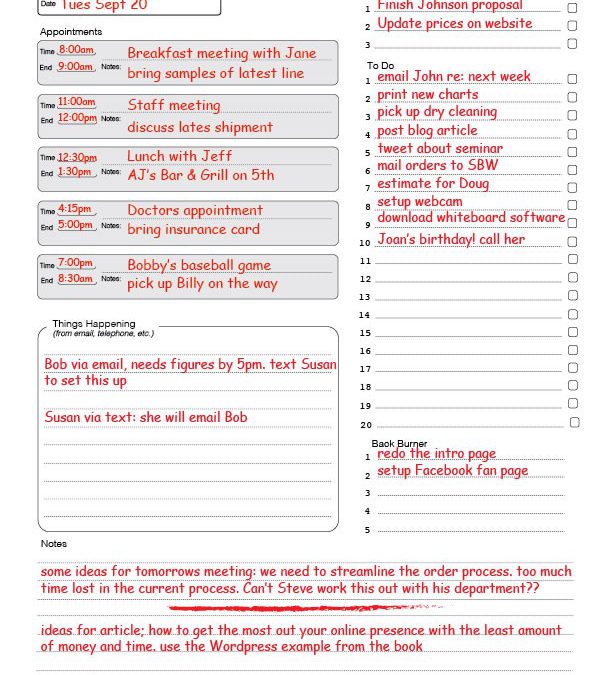Put your digital “To do” list in writing.

By minimum effort, I don’t mean you should not concentrate fully on the task at hand; but rather that you should complete the task with a minimum expenditure of energy. Being disorganized consumes energy, multitasking consumes energy, constantly being distracted consumes energy, and working solely from a digital “To do” list consumes energy.
A digital list of “things to do” on your computer or laptop can becomes long and unmanageable, with a mixture of priority and less important and trivial items – some of which must be done immediately and others later on, sometimes even months into the future.
This tends to increase your anxiety level, serves as a distraction, and wastes time as you constantly scan the items to decide which ones to work on each day. These situations consume energy that otherwise could be spent on priority tasks.
You can manage your “To do” list more effectively by separating it from your computer workstation as a handwritten list. Then you can choose a few of the most important items and record them in your planner or Daily Priority Pad, crossing them off your master list as you do so.
It’s important that you don’t choose too many items to get done in a day. Plan for only four or five hours of productive work each day, allowing up to 50% more time than you think the tasks will take. The balance of the work day will be filled by unplanned, yet important and urgent, tasks and activities that inevitably occur.
One advantage of a planning calendar over the Daily Priority Pad is that you can actually schedule a block of time for each task and have a visual view of the times that are still available for other work.
Writing down your “To do” list on paper frees up working memory, sensitizes your mind to the items to be done, allows time to evaluate their importance, and provides a motivational sense of accomplishment as you cross off each item.
Mikael Cho, cofounder of Crew, claimed that “the separation from the digital space (where I do most of my work) to the physical, helped me feel less overwhelmed.”
Physically writing things down also increases your focus on what you are doing at the time, avoids mental multitasking, and helps you to make better decisions when selecting the priorities for each day.
I personally use the “To Do” sections (referred to as “Weekly action items”) in my Taylor Planner since this allows me to assign items to specific weeks. The Daily Priority Pad (for those who don’t necessarily use a paper planner) allows you to assign them to specific days. I recommend you use whatever system works best for you.
If you’re unfamiliar with our Daily Priority Pad or Taylor Planner, you can get a description of each at taylorintime.com.
A weakness of all planning calendars, whether hard copy or electronic, is that they allow you to schedule and/or list more work than you can possibly get done. We probably all know that we should not attempt more than we can get done in any given day; because to do so causes anxiety and stress and makes us more vulnerable to distractions and inattentiveness. And when you have more to do in a week than you can possibly get done, priorities frequently take a back seat to quantity as you play catch-up.
One solution to the problem would be to take one day at a time, listing only those priorities and urgent items that could reasonably be done in a day. However it is difficult to know what comprises a day’s work.
When determining a day’s work, take into consideration the length of your working day, the interruptions that you anticipate, and the type of activities you will be involved in – and always allow up to 50% more time that you estimate your activities will take.
The Daily Priority Pad helps you to limit the essential priorities, important tasks and urgent activities to those that can be done in one day. This one-day-at-a-time approach allows greater focus, facilitates the changing priorities that occur during the week, helps you to quickly learn from experience what a day’s work really is, and frees your mind from those items that need only be addressed at a later date.
The Daily Priority Pad can be used either in conjunction with or independent of an annual planner. When used with an annual planner, such as the Taylor Planner with a week at a glance format, each page in the Daily Priority Pad is the day’s action plan distilled from the broader weekly plan outlined in your planner.
When used independently, normally by those individuals unable to realistically schedule activities as far as a week in advance, it replaces the annual planner. This short-range planning tool is needed in today’s working environment where the time between planning and action is becoming shorter each year, and in which the choices available to us are increasing exponentially.
The Daily Priority Pad retains the priority and “To do” sections of the Taylor Planner, while limiting scheduled activities to a few appointments – either with others or yourself, and a “Notes” section for additional information or journaling.
When scheduling your time, I recommend you work on 90-day goals, during 90-minute work sessions scheduled up to 90 hours in advance. I will explain this “triple 90” approach in my next blog article.
Next blog article: Using the “triple 90” method to get the important things done on time.


Recent Comments